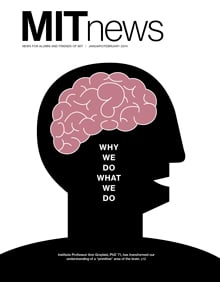Letters
Formidable Science
MIT Institute Professor Ann Graybiel has made a formidable series of discoveries, clarifying the structure and function of the forebrain and, in particular, the basal ganglia and related structures (“Why We Do What We Do,” January/February 2014). They play a major role in our ability to make decisions, learn new habits, and select at which point a given behavior should be initiated. Ann has almost single-handedly demonstrated a modular organization within the striatum, the input level of the basal ganglia. Modules of striosomes and matrisomes are intermingled, and these two compartments receive different types of information and target different output structures. Striosomes receive signals from the older parts of the cortex and directly affect the dopamine system that signals reward and promotes motor learning—indispensable elements for brain function. She then proceeded to record signals from the different cell types in the striata of animals learning to perform different tasks. She could show how the different cells change their activity during the process of learning a complex motor task. After learning is completed, the nervous system has formed a new circuit that can more or less automatically be turned on—a habit is formed.

Understanding how the brain performs these complex tasks—comprehending how our brains work—is a reward in itself. But understanding the normal function of the basal ganglia also provides a platform for new insights into the neural bases of the many neurological and psychiatric diseases of the brain and can lead to new therapies.
Sten Grillner
Professor of neurophysiology
Karolinska Institute
Stockholm, Sweden
Flying High with Beaverworks
As a Beaverworks veteran, I was pleased to see a story about the work happening in the basement of 33 in the January/February 2014 issue (“A Chance to Fly”). I was involved in the latest effort of the program, tasked by DARPA to design a modular UAV architecture satisfying a diverse set of mission requirements. Helping design, build, and flight-test three aircraft in the span of a year was challenging and offered rewarding industry experience in an academic environment.
One of the key elements in our modular framework was a common set of molds manufactured using the department’s new computer numerical control router. Scaling down composite fabrication techniques used in gliders, our team manufactured common tooling that could be used to construct all three aircraft. This molding technique accurately reproduced the desired aerodynamic surface and produced high-performance composite structures. After spending countless hours prototyping and building parts, it was satisfying to see the aircraft fly.
Kevin Durand ’13
Cambridge, Massachusetts
A TR Publisher Remembers Vest
Chuck Vest took some time to get to know MIT before he assumed the office of president in 1990. We first met when he came to my office (I was the executive vice president and CEO of the MIT Alumni Association and publisher of Technology Review at the time). In his typical plainspoken fashion, he asked what the alumni would think of him. He said, “I am not an MIT faculty member or an alumnus.” I replied, “Well, we have had one of those, Karl Taylor Compton … just do that well and you will be okay.” He said, “I really am at MIT …”
We worked very closely together to get Chuck and his wife, Becky, to meet and begin to know alumni worldwide. He traveled and listened to folks and often expressed his candid surprise and delight at being at MIT.
He led in a whole variety of ways, championing MIT’s larger roles in the nation and the world. He counted on alumni to be models and ambassadors of the Institute and spent countless hours in Washington campaigning for the ’Tute and the world of research universities. Chuck took to that role with charm and a keen ear for what was needed to make the case for the university community as a whole. He led that community from the bully pulpit of MIT.
We had our disagreements. But one disagreement, over budgets, spawned an idea. Often when our prized publication Technology Review won accolades, MIT gloried in the credit. When we went even slightly over budget, no matter how much national acclaim we had, the Alumni Association and its publisher (me) took the heat. With Association presidents Bob Metcalfe ’68 and DuWayne Peterson ’55, Chuck and I finally argued the issue through. Our position was, if MIT got the credit, MIT should get Technology Review, profits, deficits, and all.
Bob, DuWayne, and I were sure he would not go for it. But Chuck, in one of his several bold and unconventional moves, said yes: MIT would assume ownership of TR and its successes and occasional cost overruns. So I lost a magazine publishing role and gained even more admiration for a plainspoken, canny risk taker.
Bill Hecht ’61, Executive vice president and CEO emeritus
MIT Alumni Association
Tell us what you think.
E-mail mitnews@technologyreview.com
Write MIT News, One Main Street,
13th Floor, Cambridge, MA 02142
Fax 617-475-8043
Keep Reading
Most Popular
Large language models can do jaw-dropping things. But nobody knows exactly why.
And that's a problem. Figuring it out is one of the biggest scientific puzzles of our time and a crucial step towards controlling more powerful future models.
How scientists traced a mysterious covid case back to six toilets
When wastewater surveillance turns into a hunt for a single infected individual, the ethics get tricky.
The problem with plug-in hybrids? Their drivers.
Plug-in hybrids are often sold as a transition to EVs, but new data from Europe shows we’re still underestimating the emissions they produce.
Google DeepMind’s new generative model makes Super Mario–like games from scratch
Genie learns how to control games by watching hours and hours of video. It could help train next-gen robots too.
Stay connected
Get the latest updates from
MIT Technology Review
Discover special offers, top stories, upcoming events, and more.